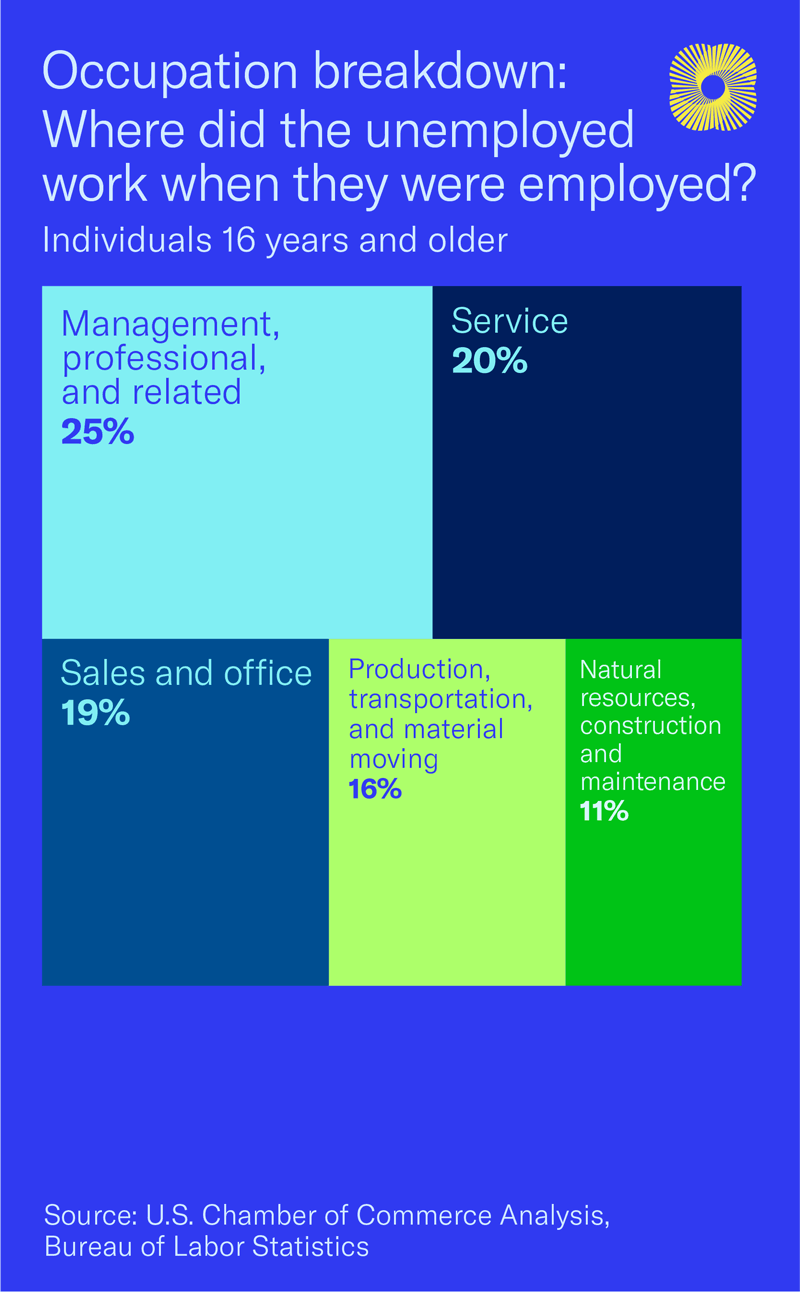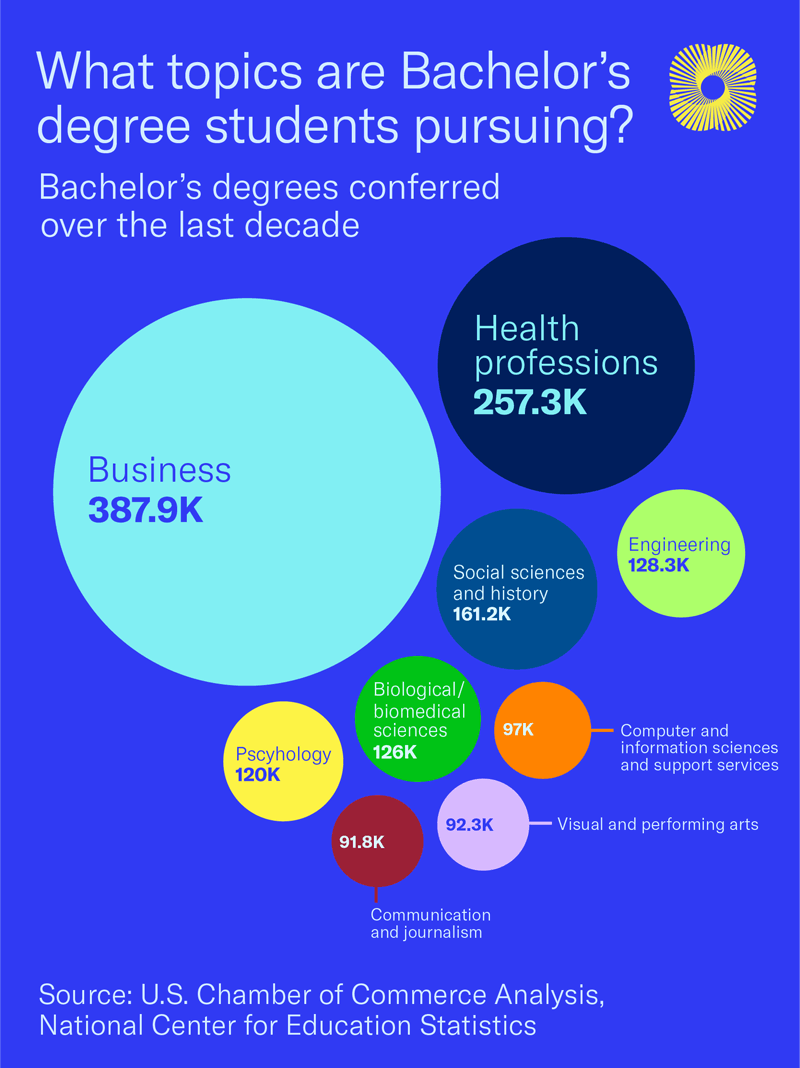 Stephanie Ferguson Melhorn
Stephanie Ferguson Melhorn
Senior Director, Workforce & International Labor Policy, U.S. Chamber of Commerce
Published
December 08, 2022
The United States is facing a labor shortage. There are too many open jobs and not enough workers to fill them. Through the America Works Initiative, the U.S. Chamber and U.S. Chamber Foundation are committed to helping businesses understand contributing factors to the labor shortage, discover overlooked talent pools, and provide solutions to help businesses attract and retain the best talent.
One overlooked talent pool is a company’s current staff. By investing in their existing workers through upskilling and reskilling initiatives, a business’s current workforce can develop the skills necessary to perform the jobs the business needs now—and the ones they will need years from now. This page dives deep into worker skills, current workforce needs, and the skills that need to be developed for the country to remain competitive in the future.
Higher education levels = lower unemployment
Since 2002, the labor force has experienced varied levels of unemployment, markedly worse during times of economic distress. However, the higher the level of education a person has achieved, the less likely they are to be unemployed. This remained true during the pandemic.
-
6.3%
Current unemployment rate for those with less than a high school diploma
-
1.9%
Current unemployment rate for those with a Bachelor’s degree or higher

The over 10 million open jobs in the U.S. right now are spread across all industries and occupations. Entry level jobs have more job openings, but also more available individuals who have the skills to fill these jobs. For job openings in more highly technical industries and occupations, there is a much smaller available talent pool with the skills needed to do these jobs.
Nearly 40% of all unemployed individuals in October 2022 previously worked in service and sales and office occupations. A quarter worked in the wholesale and retail trade and leisure and hospitality sectors.
These occupations and industries encompass many entry-level jobs that require minimal training and education. Individuals who previously worked in these occupations can quickly move between other entry level occupations in varied industries.

Right now, nearly all industries, no matter the skill level needed, are experiencing a worker shortage. However, occupations and industries that require specialized skills and training are experiencing even more severe labor shortages.
-
10%
Share of unemployed population with experience in finance, IT, or transportation jobs
-
13%
Share of unemployed population with experience in leisure & hospitality
The financial activities, information technology, and transportation industries often require a labor force with specialized skills and training. Only a combined 10% of the unemployed population has experience in these three industries, meaning there are not enough individuals in the labor market with the skills required to fill these jobs.
For jobs in those industries to be filled, the current labor force and those close to entering the labor force will need to be recruited and trained to fill these jobs.
The skills mismatch
However, the degrees undergraduate and graduate students are pursuing are not necessarily aligned with the projected jobs that will be available over the next ten years.

A Master’s in Business Administration was the most conferred Master’s degree over the last decade. Yet, none of the top projected jobs over the next ten years will require an MBA.
The chart below shows the most in-demand careers over the next decade. Among jobs that will require a Master’s degree, nurse practitioners will be in high demand. It is anticipated that more than 50,000 nurse practitioners jobs will be created over the next decade. Physician assistants and occupational therapists are also projected to be among the highest growing occupations for Master’s degree earners.

The good news: Degrees in health professions are popular. If health professional degrees continue to be pursued at the rate at which they are now, there will be a strong pipeline of talent for these professions.
But that’s not the case for all industries. For example, marriage and family therapists; substance abuse, behavioral disorder, and mental health counselors; tutors, teachers, and instructors will all be in high demand over the next ten years. However, psychology and education degrees are not being pursued at equally high rates.
In addition to relevant education and experience, a competitive workforce must acquire hard and soft skills that are often learned on the job. A recent report from World Economic Forum identified the most in-demand skills that employers are looking for—and whether those employers have programs in place to teach those skills to current employees.

Analytical and critical thinking, and active learning strategies, were among the top skills across both lists. Emotional intelligence skills were also identified as valuable, in-demand skills. Specifically, companies want employees that can demonstrate resilience, stress tolerance, and flexibility as well as leadership and social influence.
The employer’s role in upskilling
According to more than 9,000 business and HR leaders surveyed by Deloitte, 73% agreed that organizations are responsible for developing their workforce, followed by individuals themselves (54%).

Employers can consider reskilling or upskilling any person in their workforce despite experience, age, or education level. Workers in higher risk jobs like those in the service industries are the most inclined to reskill, but even those in historically safe jobs, like law, social work, and health care, are willing to reskill or upskill.
-
68%
Share of workers willing to retrain in any case
-
28%
Share of workers willing to retrain if necessary
The same holds true across all education levels. College educated individuals are nearly equally interested in reskilling and upskilling as those without formal education. Likewise, individuals of all ages are willing to upskill and reskill while the desire decreases with age.

Employers are responding to the request for reskilling and upskilling, and it’s benefiting business. When it comes to investing in skills-based training, more than half of the respondents in a U.S. Chamber Foundation and SHRM survey indicated the investment provides a return-on-investment and that existing skills gaps can be directly addressed.

Employers find value in outside education opportunities, too. Nearly three out of every four employers offer a tuition assistance program. Three-quarters (74%) of employers reported that the program provides a return-on-investment, and an equal number reported the program improves employee attention.

Employers are investing in reskilling and upskilling, but our current labor force requires even more investment. The U.S. Chamber of Commerce Foundation’s Talent Finance Initiative is exploring new ways to invest in people and skills that keep pace with innovation and advance economic opportunity, diversity, inclusion, and competitiveness.
At the same time, employees value the opportunity to be lifelong learners. Offering reskilling and education opportunities is just one of many innovative benefits offerings employers are using to attract and retain talent.
The U.S. Chamber and U.S. Chamber Foundation’s America Works Initiative also has resources and guides to help employers expand their talent pool by considering second chance hiring, providing childcare, hiring from the military community, and more, to help them find the talent they need.
For more information on the America Works Initiative contact Jenna Shrove at jshrove@uschamber.com.
Develop Your Workforce with the U.S. Chamber Foundation
Workforce development programs including Talent Pipeline Management, T3 Innovation Network, Jobs and Employment Data Exchange, and Talent Finance are ready solutions for employers who want to ensure the American economy has the skilled workforce it needs to grow.
Read More
About the authors

Stephanie Ferguson Melhorn
Stephanie Ferguson Melhorn is the Senior Director of Workforce & International Labor Policy. Her work on the labor shortage has been cited in the Wall Street Journal, Washington Post, and Associated Press.

Isabella Lucy
Isabella has created stunning visualizations tackling pressing issues like the worker shortage, the benefits of hiring veterans, the lifespan of small businesses, and the future of work.




